Abstract
Curved high-pier rigid frame bridges (CHRF bridges) are unavoidably affected by near-fault ground motions (NFGMs), and seismic pounding between adjacent components of CHRF bridge has a significant effect on the seismic performance of CHRF bridges. The seismic response and seismic pounding laws of CHRF bridges under NFGMs need further investigation. In this study, the influence of NFGMs with impulse and directional effects on the dynamic response of CHRF bridges was studied. Subsequently, the pounding responses between adjacent components of CHRF bridge were systematically analyzed. The results showed that the impulse and directional effects of NFGMs have a significant impact on the seismic response of CHRF bridges. The seismic response of CHRF bridges under near-fault impulse-like ground motions (IPGMs) is greater than that under near-fault non-pulse-like ground motions (NPGMs). CHRF bridges have the lowest seismic response under far-fault ground motions (FFGMs). The seismic response of CHRF bridges is significant under backward region ground motions (BRGMs) and the lowest under forward region ground motions (FRGMs). The IPGMs induce larger pounding force (PF) and a smaller number of poundings (PN) compared with FFGMs. The PF and the PN increase from the FRGMs to the BRGMs. Because of the pounding, the impulse and directional effects of NFGMs cause the shear force of the main pier and the auxiliary pier of CHRF bridges to increase significantly and the relative bending moment decreases. Moreover, the shear force and bending moment of the tie beam increases significantly owing to pounding.
1. Introduction
Curved high-pier rigid frame bridges (CHRF bridges) are developed as high-intensity bridges across faults owing to their excellent spanning ability, terrain adaptability, and low cost. However, near-fault ground motions (NFGMs) can easily cause irreparable damage to CHRF bridges [1,2,3,4,5]. The safety hazard of CHRF bridges under NFGMs limits their application [6,7].
NFGMs have a significant impact on the seismic response of engineering structures. Many studies have been conducted to investigate the influence of NFGMs (including impulse effects and directional effects) on the dynamic response of structures. Jia et al. [8] summarized the results on the influence of NFGMs on structures and reported that NFGMs always amplify the dynamic response of the structures. Süleyman [9] studied the effects of different ground motions, including near- and far-fault ground motions, on the seismic response of a suspension bridge. The results indicated that NFGMs cause a significant increase in the seismic response of the suspension bridge. Su et al. [10] studied the seismic response of a curved girder bridge with a longitudinal slope under NFGMs with a directional effect. The results showed that the main girder rotated more easily around the fixed pier under NFGMs. The displacement responses of the bearing and beam ends at low piers were more significant. Dhankot et al. [11] studied the effect of six far-field and 12 near-fault ground motions on the Triple Friction Pendulum (TFP) bearings. The results showed that IPGMs made the structure of used TFP bearings more susceptible to damage. Xin et al. [12] established a finite element model of a concrete-filled steel tube arch bridge and analyzed the influence of the directional and sliding effects of NFGMs on the dynamic response of the structure. Based on the results, it was proposed that the directional and sliding effects of NFGMs should be considered during the design process of concrete-filled steel tube arch bridges. Li et al. [13,14] analyzed the dynamic response of long-span cable-stayed bridges under IPGMs. The results showed that IPGMs had a significant impact on the seismic response of long-span cable-stayed bridges. Furthermore, IPGMs with fling-step pulses can cause more damage to long-span cable-stayed bridges compared with IPGMs without fling-step pulses. Xu et al. [15] studied the impact of the pulse parameters of NFGMs on the dynamic response of long-period bridge structures. Daei et al. [16] quantified the impact of the pulse effects of NFGMs on the seismic response of three-story reinforced concrete (RC) frame (MRF) buildings. Zhang et al. [17] carried out shaking table test on a double box utility tunnel and systematically analyzed the seismic behaviors of the double box utility tunnel under different ground motions. Song et al. [18] used the incremental dynamic analysis (IDA) method to analyze the influence of the directional effect of NFGMs on the fracture risk of pre-Northridge welded column splices (WCS). The results showed that the influence of the directional effect of NFGMs on the seismic response of the Pre-Northridge WCS was significant. The dynamic response law of small-span bridges and low-middle-rise buildings under NFGMs has been systematically studied. However, the seismic response of complex bridges and buildings (such as curved high-pier rigid frame bridges, suspension bridges, and super high-rise structures) under NFGMs needs further investigation.
Moreover, because of the irregular geometries and complex terrain, earthquake-induced adjacent pounding may result in more complex local damage or even collapse of CHRF bridges. Miari et al. [19] summed up previous research concerning earthquake-induced structural pounding in bridge structuresand decided on the influential factors and the suggested mitigation measures of earthquake-induced structural pounding. Muthukumar et al. [20] studied the simulation effectiveness of the force-based linear spring model and Kelvin–Hertz model for seismic pounding between adjacent structures. The results indicated that the Hertz model can provide more adequate results at low PGA levels, while the Hertz Damper model was recommended at moderate and high PGA levels. Dimitrakopoulos et al. [21] proposed a novel beam–stick model to describe the pounding behavior of curved steel girder bridges and concluded that the seismic pounding affected the displacement responses of the inelastic bridges. Han et al. [22] built a finite element model of a skewed bridge through incorporating deck–abutment joints to consider the pounding along the longitudinal and transverse direction. They found that the rotation of superstructure was affected by the pounding between the deck and abutments. Kun et al. [23,24] performed the shake table tests on a straight bridge and a skewed bridge with abutments. They thought that the pounding significantly affected the bending moments of the piers and the transverse relative displacements between the deck and the abutment. Xu et al. [25,26] studied the pounding effect and its influence on curved bridges with a small radius and a longitudinal slope subjected to near-fault ground motions. They found that pounding responses were significantly influenced by the characteristics of excitation, the peak pounding forces under bidirectional excitation were more significant, and the pounding force near the short pier was greater than that of the tall pier. Bi et al. [27,28] built a finite element model to study the surface-to-surface pounding and the torsional response induced eccentric poundings between the deck and the abutment. The results show that the influence of pounding on the displacement response of the stiff abutments can be neglected. Jiao et al. [29,30,31,32] carried out the shaking table tests and the numerical analysis to investigate the pounding effect of curved bridge. It was concluded that the maximum pounding force was related to the radius of curvature. The pounding forces can increase the relative radial displacement between the deck corners and the abutment. Based on this research, the seismic pounding has a significantly effect on the dynamic response of curved bridges. There are few existing findings on the pounding effect of CHRF bridges, especially under the near-fault ground motions.
In this study, a nonlinear analysis model of a typical CHRF bridge was established by considering the pounding between the main and approach spans based on the OpenSees platform. Subsequently, different types of ground motions were selected based on the PEER database, including near-fault pulse-like ground motions (IPGMs), near-fault non-pulse-like ground motions (NPGMs), far-fault ground motions (FFGMs), forward region ground motions (FRGMs), middle region ground motions (MRGMs), and backward region ground motions (BRGMs). The seismic response law of CHRF bridges under these different ground motions was investigated, including the internal force and displacement response of key parts (the direction of shear and bending moment was the same as the direction of ground motion excitation). Furthermore, the pounding response between adjacent components of CHRF bridge was systematically analyzed, and the influence law of the seismic pounding on the dynamic response of CHRF bridge was clarified.
2. Prototype Bridge
The span arrangement of the prototype CHRF bridge was 3 × 30 + 66 + 130 + 66 + 4 × 30 m (shown in Figure 1a). The radius of curvature of the bridge was 650 m (shown in Figure 1b). The main beam of the bridge was a single continuous box girder with a variable cross-section. The cross-section height was 7.0 m near the pier-beam consolidation and 2.8 m at the middle section (shown in Figure 1c,d). The cross-section width was 12.0 m at the top and 6 m at the bottom. The concrete strength of the main girder was C55. The main substructure of the bridge was a double-limbed thin-walled pier (the longitudinal and transverse sizes of the pier were 6500 mm × 1900 mm) (shown in Figure 1e), the longitudinal and transverse sizes of the tie beam were 5500 mm × 1900 mm (shown in Figure 1f). The side substructure of the bridge was a double-limbed thin-walled rectangular hollow pier (the longitudinal and transverse sizes of the pier were 6500 mm × 2600 mm) (shown in Figure 1g), and the concrete strength of the substructure was C40. The adjacent bridge was a continuous beam bridge. The substructure of the adjacent bridge was rectangular hollow piers. The longitudinal reinforcement of the substructure was HRB335, and the stirrup of the substructure was HRB300. The bearing systems of the bridge were all basin-type rubber bearings. The expansion joints were arranged between the main bridge and adjacent bridge, bridgeheads, and embankment of the adjacent bridge. The gap size of the expansion joints between the main bridge and the adjacent bridge was 240 mm.

Figure 1.
Elevation of the full bridge (unit: cm).
3. Numerical Model
3.1. Main Parameters
The main beam of the bridge generally does not enter the plastic state during dynamic analysis. The elastic beam-column elements were selected to construct the main beam of the bridge. The main girder had 270 nodes and 269 elements. Nonlinear beam-column fiber elements were selected to model the piers and tie beams. The cross-sections of the piers and tie beams were composed of three types of fibers: unconstrained concrete, constrained concrete, and steel bars. Concrete 01 was used to model the concrete (Figure 2, Detail 2). Steel 02 was used to model the reinforcement. The material properties of reinforcement and concrete in the model are shown in Table 1. The bearing was simulated using zero-length elements, and its constitutive model was a bilinear hysteretic model. In addition, a pounding element was set at the expansion joints of the bridge to simulate the pounding between the main bridge and adjacent bridges at the expansion joints. The constitutive model of the pounding element was the Hertz-damp model. A finite element model of the full-bridge is shown in Figure 2. Newmark-beta method was chosen to solve the equation of motion for dynamic analysis in OpenSees 3.3.0. The parameters of the Newmark-beta were selected as γ = 0.5, β = 0.25.
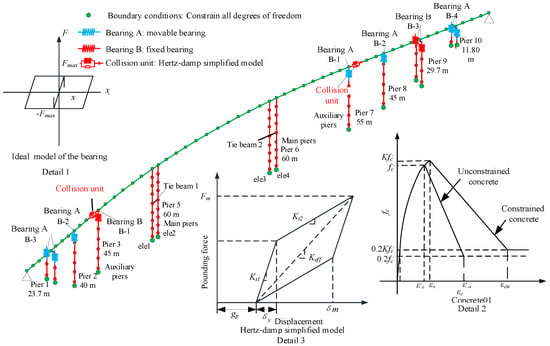
Figure 2.
Schematic diagram of the full-bridge finite element model.

Table 1.
Material properties of reinforcement and concrete in the model.
3.2. Bearing Parameters
Bilinear elastoplastic elements were used to simulate the pot rubber bearings to consider the sliding friction of the actual bearings. The restoring force model of the bearings is shown in Figure 2 (Detail 1). The critical sliding friction force (Fmax) and the initial stiffness of the bearing are expressed as follows:
where ud is the sliding friction coefficient (generally equal to 0.02). R is the weight of the superstructure (kN), and xy is the horizontal yield displacement of the bearing (generally equal to 0.002–0.005 m). The parameters of each bearing are given in Table 2.

Table 2.
Bearing parameters.
3.3. Pounding Parameters
The natural vibration periods of the main bridge and adjacent bridge were significantly different. Similarly, the displacement responses of the main bridge and adjacent bridge were different. The main bridge is prone to pounding with an adjacent bridge near the expansion joint. To examine the pounding effect on the seismic response of the CHRF bridge, a simplified Hertz-damp model was used to simulate the pounding between the main and adjacent bridges (Figure 2, Detail 3). The equivalent stiffness of the pounding element (Keff) is expressed as follows:
where Kh is the pounding stiffness of the Hertz-damp model. The pounding stiffness is equal to the first-order modal stiffness of the bridge, which can be calculated based on previous studies [19,25]. δm is the maximum intrusion displacement between the two contact surfaces. In this case, the energy dissipation of one-circle pounding can be expressed as follows:
where δy is the yield displacement of the pounding model, which can be calculated as δy = aδm. The yield parameter, a, was set to 0.1. Kt1 is the initial stiffness of the pounding model. Kt2 is the strain-hardening stiffness of the pounding model. In this case, the equivalent stiffness Keff is calculated as:
Equations (4) and (5) can be combined to calculate the initial stiffness, Kt1, and strain hardening stiffness, Kt2, of the simplified model, as follows:
In contrast, the energy dissipation, ΔE, of one-circle pounding for the Hertz-damp model can be expressed as:
On the basis of this equation, the pounding parameters of the Hertz-damping model can be obtained by combining Equations (7) and (8). In this study, the relevant design parameters of the pounding model were as follows: the initial gap, g, was 240 mm. The invasion displacement, δm, was 24 mm [33]. The Hertz index, n, was 1.5. The regression coefficient, e, was equal to 0.6. The theoretical collision stiffness, Kh, was 8910 kN/m3/2. The equivalent stiffness, Keff, was 43,652 kN/m, and the initial stiffness, Kt1, was 155,402 kN/m. The strain hardening stiffness, Kt2, was 31,235 kN/m.
3.4. Basic Dynamic Characteristics of the Numerical Model
The five basic dynamic parameters of the numerical model built by using OpenSees and Midas Civil platforms (design platform) are listed and compared in Table 3.

Table 3.
Comparison of the first five modes of the model.
As presented in Table 3, the errors of the first five vibration frequencies between the OpenSees analysis results and the Midas Civil results are both within 10%. Based on the setting parameters of the two numerical models, the potential source of discrepancy of the natural vibration periods between the OpenSees and Midas modes includes the difference between the fiber element dimensions of the main pier, the section division of the main pier, and the section division of the main girder. The OpenSees analysis model can be used for the subsequent nonlinear time history analysis of the CHRF bridge.
3.5. Analysis Cases
The input ground motions are required to be consistent with the target response spectrum [34]. Hence, to select effective ground motions, firstly, the design spectrum of the prototype bridge was determined based on the JTG/T 2231-01-2020. Then, the near-fault non-pulse ground motions (NPGM) were selected to satisfy the design spectrum. The selected principle of the NPGMs is that the error between the design spectrum value and the spectrum value of the selected ground motions is less than 20% at the typical natural vibration periods of the bridge. Subsequently, the fault distance was chosen as >60 km or <20 km to select the far-fault or near-fault ground motions. Additionally, the impulse-like ground motion was selected among the above near-fault ground motions with certain pulse periods. Finally, the directional effect ground motions were selected according to the position relationship between the fault region and the location of seismograph station. If the seismograph station is located near the rupture zone, the recorded ground motions is defined as MRGMs. If the seismograph station is located in front of the extension direction of the rupture zone, the recorded ground motions is defined as FRGMs. If the seismograph station is located behind the extension direction of the rupture zone, the recorded ground motions are defined as BRGMs.
To analyze the dynamic response of a CHRF bridge under different NFGMs, we selected 42 ground motions from the latest database of the PEER NGA-West 2, including near-fault impulse ground motions (IPGM), near-fault non-pulse ground motions (NPGM), and far-fault ground motions (FFGM), which were selected as the input ground motions to consider the pulse impact on the dynamic response of the CHRF bridge. Furthermore, NFGMs in the forward region (FR), in the middle region (MR), and in the backward region (BR) were also selected as the input to consider the directional effect on the dynamic response of the CHRF bridge. Seven ground motions were selected for each type of NFGMs. Additionally, the dynamic response (bending moment, shear force, and pounding force) was the average value from each of the seven ground motions. Figure 3 shows the response spectrum curves and their average values for the six types of NFGMs. Table 4 shows the detailed record of each ground motion.
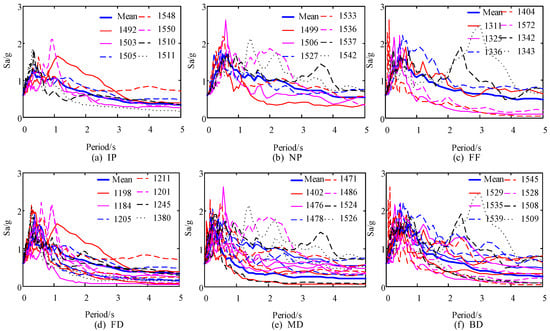
Figure 3.
Seismic response spectra of NFGMs.

Table 4.
Detailed records of NFGMs.
As shown in Figure 3 and Table 4, the IPGMs have velocity pulses. The velocity pulse period is significantly large (>4 s). The response spectrum value of the IPGMs is greater than that of the NPGMs and FFGMs over a long period. The response spectrum value of MRGMs is greater than that of FRGMs and BRGMs. Ground motions in the area before the rupture often have obvious velocity pulses, and the long-period response spectrum values of the rupture area and the area before the rupture are larger than those of the area behind the rupture. During the simulation, all the selected ground motions were input along the X-direction excitation (tangential of the bridge), Y-direction excitation (radial of the bridge), and X + Y-direction excitation (the above two directions). The peak acceleration value of each ground motion was adjusted to 0.6 g.
4. Dynamic Response of the Original CHRF Bridge
4.1. Pulse Effect
4.1.1. Main Pier (Pier 5 and Pier 6)
Figure 4 shows the typical time history curves of the shear force at the bottom of the main pier under different ground motions.

Figure 4.
Shear time history of main pier bottom; (a) X direction; (b) Y direction; and (c) X + Y direction.
As Figure 4 shown, the IPGMs (RSN1550) cause significant residual displacements of the main piers, whereas NPGMs and FFGMs do not cause significant residual displacements of the main piers. It should be noted that the residual displacement is not zero; this may be caused by the situation that the displacement integral of the impulse-like acceleration time history itself is not zero. It is a hotspot study to consider the low frequency component of the NFGMs on the residual displacements of CHRF bridges in future. The shear force of the main piers under IPGM and NPGM is significantly larger than that of the main piers under FFGMs. IPGMs are more destructive to curved bridges. Figure 5 shows a comparison of the shear force and the bending moment at the bottom of the main pier caused by IPGMs, NPGMs, and FFGMs. The pier numbers are shown in Figure 3.
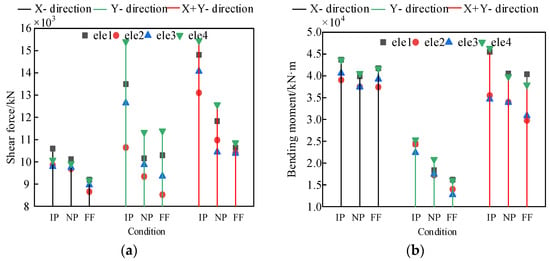
Figure 5.
Internal force of the main pier bottom; (a) shear force; (b) bending moment.
As shown in Figure 5, the internal forces of ele1 and ele4 are similar, and the internal forces of ele2 and ele3 are similar. The internal forces of ele1 and ele4 are larger than those of ele2 and ele3. The internal force of the pier bottom is the largest under IPGMs and smallest under FFGMs. The pier bottom shear force of the CHRF bridges under IPGMs is approximately 1.22–1.58 times larger than that under FFGMs. The bending moment of the pier bottom under IPGMs was approximately 1.17–1.74 times larger than that under FFGMs. The shear force of the pier bottom under NPGMs was approximately 1.17–1.33 times larger than that under FFGMs. The bending moment of the pier bottom under NPGMs was approximately 1.07–1.49 times larger than that under the FFGMs. The results show that IPGMs have a significant effect on the dynamic response of CHRF bridges. In addition, the shear force of the pier bottom under bidirectional excitations was approximately 1.18–1.53 times larger than that under the X-direction excitation. The bending moment of the pier bottom under bidirectional excitations was approximately 1.01–1.18 times larger than that under the Y-direction excitation. Thus, the dynamic response of the pier bottom under bidirectional excitations was significantly larger than that under unidirectional excitations.
4.1.2. Tie Beams and Auxiliary Piers (Pier 3)
Figure 6 shows the time history curve of the bending moment of the tie beam and the auxiliary pier under typical NFGMs.

Figure 6.
Bending moment time history of tie beam and auxiliary pier; (a) X direction of tie beam; (b) Y direction of tie beam; (c) X + Y direction of tie beam; (d) X direction of auxiliary pier; (e) Y direction of auxiliary pier; and (f) X + Y direction of auxiliary pier.
As shown in Figure 6a–c, the bending moment of the tie beam was the largest under the action of IPGM. The bending moment of the tie beam was the smallest under the action of FFGM. Near-fault ground motions (IPGM and NPGM) caused obvious residual internal forces in the tie beams. The bending moment of the tie beam under two-way excitation was higher than that under one-way excitation. Two-way excitation caused significant damage to the tie beam.
As shown in Figure 6d–f, the bending moment of the auxiliary pier under the action of IPGM was relatively large for the three excitation methods. The structural response under the action of NPGM was greater than that under the action of FFGM and even exceeded the moment of the auxiliary pier under the action of IPGM. The structure had the least response under the action of the FFGM. The bending moment of the auxiliary pier with bidirectional excitation was higher than that of the auxiliary pier with unidirectional excitation. Figure 7 shows a comparison of the shear and bending moments of tie beams and auxiliary piers under the action of three excitation methods, IPGMs, NPGMs, and FFGMs.
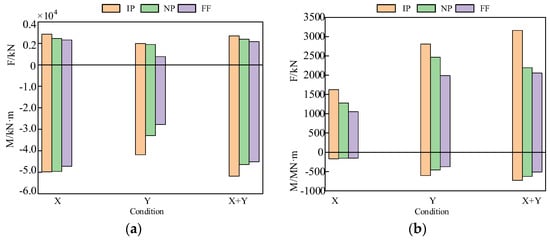
Figure 7.
Shear bending moment of tie beam and auxiliary pier; (a) tie beam internal force; (b) auxiliary pier internal force.
As shown in Figure 7a, the internal force of the tie beam under the action of IPGMs was greater than that under NPGMs; however, the internal force response of the tie beam was the smallest under FFGMs. The bending moment of the tie beam under IPGMs and NPGMs was approximately 1.23–2.59 and 1.06–2.47 times larger than that under FFGMs. The shear force of the tie beam under IPGMs and NPGMs was approximately 1.06–1.51 and 1.03–1.19 times larger than that under FFGMs. In addition, the bending moment response of the tie beam under IPGMs was significantly large. The bending moment response of the tie beam exceeded the bending moment of the main pier under two-way excitation. Therefore, the development of plastic hinges of tie beams of super-high pier bridges may precede the development of plastic hinges of the main pier. The energy dissipation design of the tie beam is an important structural measure of the seismic resistance of super-high-pier bridges.
As shown in Figure 7b, under the three excitation conditions, the internal force response change of the auxiliary pier was similar to that of the tie beam. The internal force of IPGMs was the maximum, and the NPGMs’ seismic action was minimized. The auxiliary pier bending moments under IPGMs and NPGMs were about 1.14–1.61 and 1.03–1.23 times larger than that under FFGMs. The auxiliary pier shear force under IPGMs and NPGMs were approximately 1.41–1.54 and 1.07–1.21 times larger than that under FFGMs. The internal force provided by the auxiliary piers under X-direction excitations was minimized, and the laterally fixed bearings could realize the internal force distribution of each pier.
4.1.3. Bearing
Figure 8 shows the shear forces along the bridge of the B-1–B-4 bearings under different ground motions.
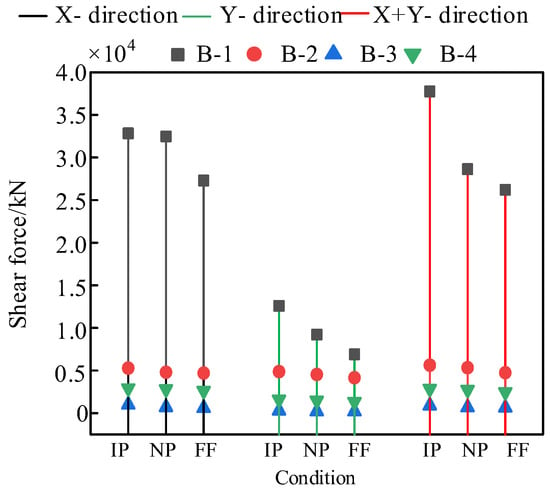
Figure 8.
Shear force of bearing under pulse effect ground motions.
As shown in Figure 8, the bearing shear force along the bridge under Y-direction excitation was small, and the displacement demand along the bridge was small. Under X + Y direction excitation, the bearing had the largest shear force along the bridge. This is mainly because the dynamic response along the bridge of the structure was high. The auxiliary pier bore a large vertical load, and the transmitted shear force was large. The B-1 bearing had the largest shear force along the bridge. The B-2 bearing had the second largest, and the B-3 bearing had the smallest shear force along the bridge. IPGMs support the largest shear force, while FFGMs support the smallest shear force.
In summary, under the action of ground motions, the internal force responses are relatively large, for example, the internal force response of the bottom section of the main pier, auxiliary pier, the connection between the pier and the beam, and the connection between the tie beam and the main pier. Key sections should be considered in the design. In addition, the tie beam may be affected before the main pier of the CHRF bridge. Therefore, the energy dissipation design of the tie beam is a significant part of the seismic design of CHRF bridges. IPGMs have a greater impact on CHRF bridges owing to their pulse characteristics. The internal forces under FFGMs are the smallest. The impact of near-fault ground motions should be considered in the seismic design of CHRF bridges, especially the impact of near-fault pulse-type ground motions.
4.2. Directional Effect
4.2.1. Main Pier (Pier 5 and Pier 6)
Figure 9 shows the typical time history curve of the shear force at the bottom of the main bridge pier under different ground motions.
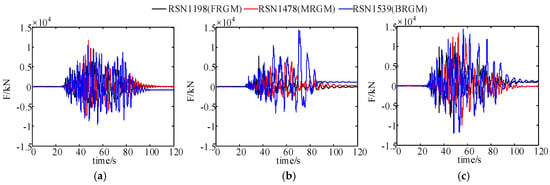
Figure 9.
Shear force time history of main pier bottom; (a) X direction; (b) Y direction; and (c) X + Y direction.
As presented in Figure 9, the shear force at the bottom of the main pier was the largest under BRGMs. However, the shear force at the bottom of the main pier was the smallest under FRGMs. The shear force at the bottom of the main pier under two-way excitation was significantly greater than that under one-way excitation. Figure 10 shows a comparison of the shear force and the bending moment at the bottom of the main pier considering the directional effects of ground motions under the three excitation methods.
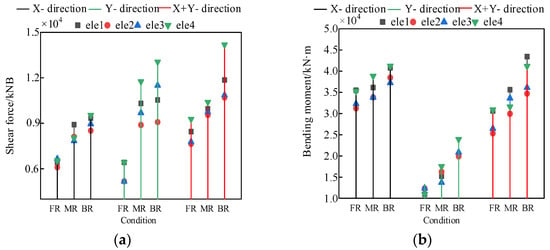
Figure 10.
Pier bottom shear moment; (a) shear force at pier bottom; (b) bending moment at pier bottom.
As shown in Figure 10, for the three excitation methods, the internal force at the bottom of the main pier was the largest under BRGMs; however, the internal force at the bottom of the CHRF bridges was the smallest under FRGMs. The pier bottom shear force and bending moment at the pier bottom of the CHRF bridges under MRGMs were approximately 1.36–2.27 and 1.24–2.30 times larger than those under FRGMs. The pier bottom shear force and bending moment of the CHRF bridges under BRGMs were about 1.56–2.53 and 1.32–3.14 times larger than those under FRGMs. BRGMs affect CHRF bridges significantly. In addition, the internal force of the pier bottom of the CHRF bridges under bidirectional excitation is significantly greater than that under unidirectional excitation. The shear force of the pier bottom of the CHRF bridges under bidirectional excitation was approximately 1.34–1.46 times larger than that under the X-direction excitation. BRGMs significantly increase the internal force of CHRF bridges. MRGMs have a greater influence on the internal force of CHRF bridges than FRGMs.
4.2.2. Tie Beams and Auxiliary Piers (Pier 3)
Figure 11 shows the typical time history curve of the bending moment of the tie beam and the auxiliary pier under different ground motions.
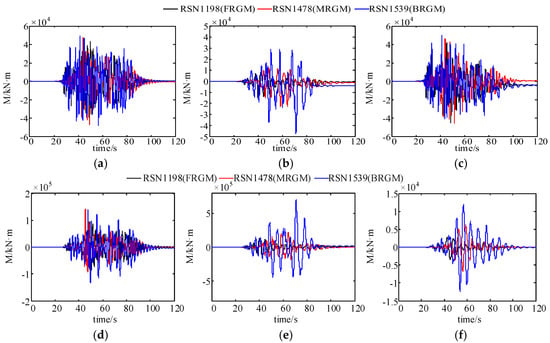
Figure 11.
Internal force time history of tie beam and auxiliary pier; (a) X direction of tie beam; (b) Y direction of tie beam; (c) X + Y direction of tie beam; (d) X direction of auxiliary pier; (e) Y direction of auxiliary pier; and (f) X + Y direction of auxiliary pier.
As shown in Figure 11a–c, under the three excitation modes, the bending moment of the tie beam was the largest under BRGM (RSN1539). However, the bending moment of the tie beam was the smallest under FRGM (RSN1198). The bending moment of the tie beam under two-way excitation was significantly greater than that under one-way excitation. Two-way excitation generated a significant residual internal force under the three typical ground motions, indicating that the structure had a plastic failure.
As shown in Figure 11d–f, the bending moment of the auxiliary pier was the largest under BRGM (RSN1539), and the moment of the auxiliary pier was the smallest under FRGMs (RSN1198). Figure 12 shows a comparison of the internal forces of the tie beams and auxiliary piers considering the directional effects of ground motions under the three excitation methods.
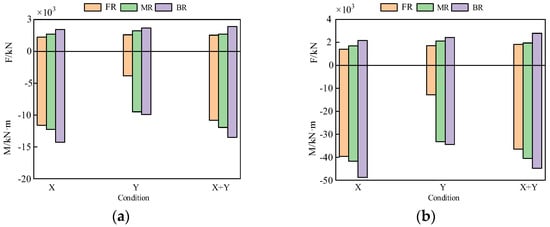
Figure 12.
Shear bending moment of tie beam and auxiliary pier; (a) tie beam internal force; (b) auxiliary pier internal force.
As shown in Figure 12, the internal force of the tie beam and auxiliary pier was the largest under BRGMs; however, the internal force was the smallest under FRGMs. The shear force of the tie beams and auxiliary piers of the CHRF bridges under MRGMs were approximately 1.05–2.60 times larger than that under FRGMs, and the shear force of the tie beams and auxiliary piers of the CHRF bridges under BRGMs were approximately 1.23–2.69 times larger than that under FRGMs. It should be noted that the impact of near-fault ground motions on the internal force of auxiliary piers was more significant. Therefore, the design of structural auxiliary piers should focus on the seismic design of CHRF bridges.
4.2.3. Bearing
Figure 13 shows the shear forces in the bridge direction of B-1–B-4 bearings under different ground motions.
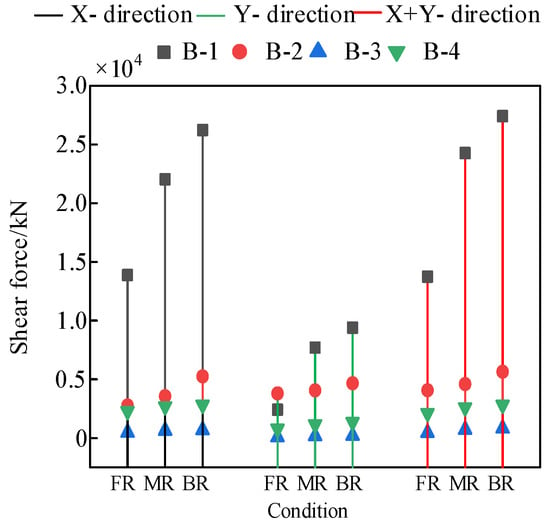
Figure 13.
Shear force of bearing under directional effect ground motions.
As shown in Figure 13, the shear force of the bearings was the largest under BRGMs. However, the shear force of the bearings was the smallest under FRGMs. Under Y-direction excitation, the shear force of the bearings was the smallest. While the shear force of the bearings under bidirectional excitation was the largest, the dynamic response of the structure was higher. The relationship between the magnitude of the shear force of the B-1–B-4 bearings caused by the directional effect of ground motion was the same as the relationship caused by the pulse effect ground motion.
4.3. Pounding Response and Impact
4.3.1. Pounding Response
Table 5 shows the average pounding force (PF) and the number of poundings (PN) at the beam ends under the action of the three excitation methods under different ground motions. Figure 14 shows the acceleration time history of the main beam and the time history curve of the pounding force under typical ground motions.

Table 5.
Statistics of pounding force and number of poundings.
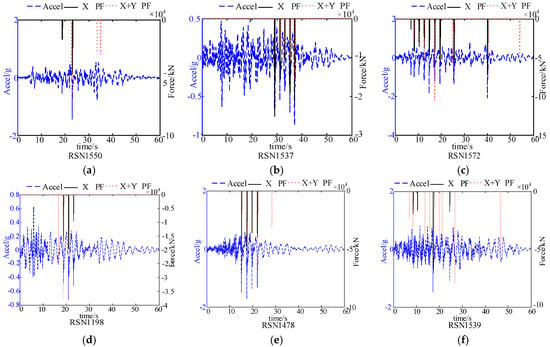
Figure 14.
Time history curve of pounding forces and their influence on acceleration response; (a) IP, (b) NP, (c) RF, (d) FR, (e) MR, and (f) BR.
As shown in Table 5 and Figure 14, the impact response of the main and approach bridge of the CHRF bridges was significantly affected by the ground motion. The peak pounding forces between the main and approach bridge under the three types of ground motions were PFIP > PFNP > PFFF, and the poundings under the three types of ground motions were PNIP < PNNP < PNFF. Therefore, from the above observations, it can be inferred that the velocity pulse of IPGMs significantly increased the seismic response of the structure. The velocity pulse caused the peak force of pounding between the main and approach bridges (within the range of the velocity pulse duration). The frequency spectrum range of FFGMs was wide, and the ground motion response was stable. Thus, FFGMs will cause a sizeable pounding within a certain period of time, even if the pounding force is small. The pounding force coincided with the peak point of the acceleration time history of the main beam. The duration of pounding had a significant influence on the acceleration of the main beam. The instantaneous acceleration under IPGMs was large, and the number of poundings was low. The damage caused by pounding should not be ignored. The PNs under FFGMs were larger than that under IPGMs, and the peak acceleration of the main beam under FFGMs was smaller than that under IPGMs.
Moreover, the rupture direction effect of the near-fault ground motion was significant for the pounding response between the main and approach bridges of the CHRF bridges. The peak pounding force between the main and approach bridges caused by the three types of ground motions in the rupture zone satisfied PFBR > PFMR > PFFR, and the corresponding pounding times satisfied PNBR > PNMR > PNFR. Based on the aforementioned observations, it can be inferred that the higher PF and the increased PNs under BR were mainly due to the smaller fault distance. The MRGMs continued to propagate forward, and the Doppler effect became obvious. The propagation process releases energy; therefore, the PN increases, and the PF increases.
4.3.2. Pounding Impact
Table 6 shows a comparison of the maximum shear force (SF) and bending moments (BM) of the critical components with pounding (P) and without pounding (NP) under different ground motions, with impulse and directional effects.

Table 6.
Statistics of shear force and bending moment of each component.
As shown in Table 6, under the impulse and directional effect of ground motions, the shear force of the main pier increases significantly, and the bending moment of the main pier decreases owing to pounding. The shear force and bending moment of the tie beam increase owing to pounding. Therefore, pounding has a significant impact on the tie beams. The shear force of the pier is reduced, and the bending moment of the auxiliary pier increases significantly owing to pounding. The internal forces of the structure under IPGMs are greater than those under FFGMs, with and without pounding. The pounding under the near-fault ground motion is more obvious. Therefore, pounding reduction measures should be implemented for bridge structures near faults. The internal force of the structure under BRGMs, with and without pounding, was the largest, and the internal force of the structure under FRGMs, with and without pounding, was the smallest. When CHRF bridges were excited under the impulse and directional effect of ground motions, the bending moment and shear force of the tie beam increased significantly after the pounding. Therefore, an energy dissipation design should be developed to avoid damage due to near-fault earthquakes. It should be noted that when the pounding occurs, the acceleration response of the main girder increases (as Figure 14 shown). Therefore, the inertia force of the main girder increases. Additionally, the pier top shear force will increase. On the other hand, the pounding may induce high-order vibration mode of the main pier. Additionally, the pier bottom shear force and the pier bottom bending moment are affected by high-order vibration of the main pier and connection of the tie beam. Thus, it is hard to clarify the variation trends of the pier bottom shear force and pier bottom bending moment after pounding.
Figure 15 shows the time history curves of the shear and bending moments of the critical section under typical ground motions.
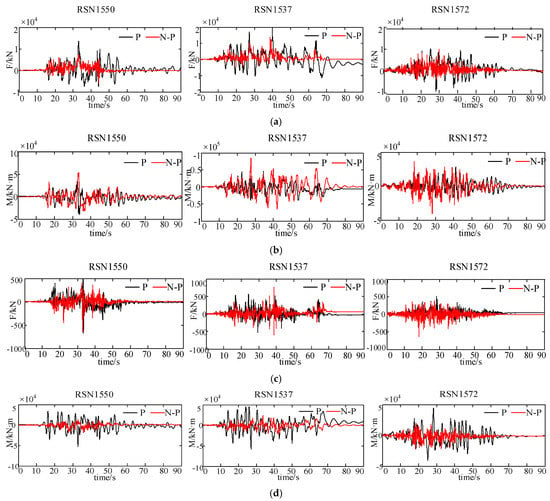
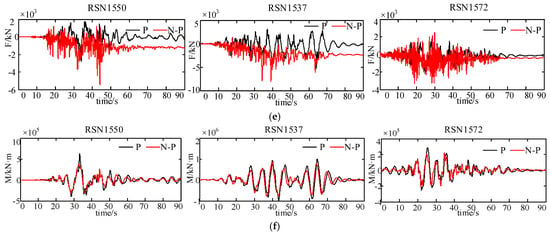
Figure 15.
Internal force time history curve of critical section with and without pounding; (a) X + Y shear force time history curve of main pier; (b) X + Y bending moment time history curve of main pier; (c) X + Y shear force time history curve of tied beam; (d) X + Y bending moment time history curve of tie beam; (e) X + Y shear force time history curve of auxiliary pier; and (f) X + Y bending moment time history curve of auxiliary pier.
As Figure 15a,b shows, the shear force of the main pier time history curve increases significantly with pounding, and the bending moment time history curve decreases. The shear force time history curve of the IPGM increases obviously in the pulse period, and the pounding has a significant impact on the pulsed ground motions. The internal force of the structure of the IP and NP ground motions is much greater than that of the FFGM, and all three excitation methods show this change. The shear force and bending moment of the main pier bottom of the IPGM (RSN1550) are slightly smaller than those of the NPGMs. This is because the structure response of the IPGM is obvious only in the pulse period.
As shown in Figure 15c,d, the shear force and the bending moment of the tie beam increased significantly after pounding. Owing to the pounding under the three excitation methods, the shear force of the tie beam under IP and NP ground motions increased, and the shear force under FFGMs decreased. Therefore, pounding had an adverse effect on the bending moment of the tie beam. The bending moment of the tie beam was relatively large; therefore, the bending failure of the tie beam should be considered in the design. The internal force of the structure, with and without pounding, under the two near-fault ground motions, was greater than that under far-fault ground motions, and this was observed under all three excitation methods.
As shown in Figure 15e,f, the shear force time history curve of the IPGMs increases significantly in the pulse period, and the bending moment time history curve of the structure with pounding under the three pulse-effect ground motions is significantly higher than that of the structure without pounding. Owing to the pounding under the three excitation methods, the shear force of the auxiliary pier generally decreased, and the bending moment of the auxiliary pier increased. The internal force of the structure, with and without pounding, of the two near-fault seismic waves was much greater than that of the far-fault ground motion. The structural internal force of the auxiliary pier of the IPGM (RSN1550) was smaller than that of the NPGM (RSN1537).
In summary, the internal force of the structure under the directional effect of ground motion exhibited the same change trends as that under the pulse effect ground motion with and without pounding. The shear force of the main pier and the auxiliary pier were significantly increased, and the shear force and bending moment of the tie beam were significantly increased. However, the bending moment of the main pier and auxiliary pier decreased significantly. As shown in Table 5, the structure had the largest response under BRGMs and had the smallest response under FRGMs; therefore, the internal force time history curve of each component of the ground motion with different directional effects is not given. It should be noted that this study is mainly focused on the dynamic response and pounding response of the CHRF bridges under horizontal ground motions. The influence of vertical components and spatial variation of ground motions on the CHRF bridges, as well as the plasticity/damage of the main girder of CHRF bridges, will be the main focus of study in future.
5. Conclusions
In this study, a nonlinear analysis model of a curved high-pier rigid frame bridge (CHRF bridge) was established using the OpenSees platform. The seismic response law of the CHRF bridge was symmetrically analyzed under different near-fault ground motions (NFGMs). Subsequently, the pounding response between adjacent components of CHRF bridge was investigated, and the influence law of the seismic pounding on the dynamic response of CHRF bridge was clarified. The main conclusions are as follows:
- The seismic response of CHRF bridges under IPGMs is significantly larger than that of under NPGMs, while the dynamic response of CHRF bridges under FFGMs is minimum. IPGMs induce a larger pounding force and a smaller number of poundings compared with FFGMs. The energy dissipation design of the tie beam is a significant part of the seismic design of CHRF bridges under the NFGMs.
- The directional effect of NFGMs has a significant impact on the seismic response of CHRF bridges. The internal force of the structure and the shear force of the bearing are the largest under BRGMs, and the seismic response of the structure is the smallest under FRGMs. The directional effect of ground motions results in a trend that the pounding force and the number of poundings increase from the FRGMs to the BRGMs.
- Comparing the cases with pounding with the cases without pounding, under the pulse effect and directional effect of ground motions, the shear force of the main pier increased and the bending moment of the main pier decreased, the bending moment of the tie beam increased, the shear force of the auxiliary pier decreased, and the bending moment of the auxiliary pier increased.
Author Contributions
Conceptualization, J.W., W.X. and W.Z.; methodology, J.W., W.X., N.L. and Y.C.; software, Y.Z., J.W. and N.L.; supervision, Y.C.; validation, W.Z.; writing—original draft preparation, Y.Z.; writing—review and editing, W.X. All authors have read and agreed to the published version of the manuscript.
Funding
This research was partly supported by the National Natural Science Foundation of China, through Grant Nos. 51978021, 51908015, 52108428, 52178446 is greatly appreciated. This research was partly supported by National Key R&D Program of China, through Grant No. 2017YFC1500604. This work was also partly supported by the Project funded by Beijing Municipal Education Commission (Grant No. KM201910005020) and the Basic Research Fund of Beijing University of Technology (Grant No. 004000546318524).
Institutional Review Board Statement
Not applicable.
Informed Consent Statement
Not applicable.
Data Availability Statement
All data generated or analyzed during this study are included in this article.
Conflicts of Interest
The authors declare that they have no known competing financial interests or personal relationships that could have influenced the work reported in this paper.
Nomenclature
| BR | backward region |
| BRGMs | backward region ground motions |
| CHRF bridges | curved high-pier rigid frame bridges |
| FF | far-fault |
| FFGMs | far-fault ground motions |
| FR | forward region |
| FRGMs | forward region ground motions |
| IP | impulse-like |
| IPGMs | impulse-like ground motions |
| NFGMs | near-fault ground motions |
| NP | non-pulse-like |
| NP-BM | bending moments without pounding |
| NPGMs | non-pulse-like ground motions |
| NP-SF | shear force without pounding |
| MR | middle region |
| MRGMs | middle region ground motions |
| P-BM | bending moments with pounding |
| PF | pounding force |
| PN | number of poundings |
| P-SF | shear force with pounding |
References
- Mavroeidis, G.P.; Dong, G.; Papageorgiou, A.S. Near-fault ground motions, and the response of elastic and inelastic single-degree-of-freedom (SDOF) systems. Earthq. Eng. Struct. Dyn. 2004, 33, 1023–1049. [Google Scholar] [CrossRef]
- Baker, J.W. Identification of Near-Fault Velocity Pulses and Prediction of Resulting Response Spectra. In Proceedings of the Geotechnical Earthquake Engineering and Structural Dynamics IV, Sacramento, CA, USA, 18–22 May 2008. [Google Scholar]
- Bray, J.D.; Rodriguez-Marek, A. Characterization of forward-directivity ground motions in the near-fault region. Soil Dyn. Earthq. Eng. 2004, 24, 815–828. [Google Scholar] [CrossRef]
- Chopra, A.K.; Chintanapakdee, C. Comparing response of SDF systems to near-fault and far-fault earthquake motions in the context of spectral regions. Earthq. Eng. Struct. Dyn. 2001, 30, 1769–1789. [Google Scholar] [CrossRef]
- Zhang, S.; Wang, G. Effects of near-fault and far-fault ground motions on nonlinear dynamic response and seismic damage of concrete gravity dams. Soil Dyn. Earthq. Eng. 2013, 53, 217–229. [Google Scholar] [CrossRef]
- Lin, Y.; Bi, K.; Zong, Z.; Hao, H.; Lin, J.; Chen, Y. Seismic Performance of Steel-Concrete Composite Rigid-Frame Bridge: Shake Table Test and Numerical Simulation. J. Bridg. Eng. 2020, 25, 04020032. [Google Scholar] [CrossRef]
- Zong, Z.; Xia, Z.; Liu, H.; Li, Y.; Huang, X. Collapse Failure of Prestressed Concrete Continuous Rigid-Frame Bridge under Strong Earthquake Excitation: Testing and Simulation. J. Bridg. Eng. 2016, 21, 04016047. [Google Scholar] [CrossRef]
- Jia, J.; Du, X.; Han, Q. Research progress on the characteristics of near-fault ground motions and their effects on engineering structures. J. Build. Struct. 2015, 36, 1–12. [Google Scholar]
- Adanur, S.; Altunişik, A.C.; Bayraktar, A.; Akköse, M. Comparison of near-fault and far-fault ground motion effects on geomet-rically nonlinear earthquake behavior of suspension bridges. Nat. Hazards 2012, 64, 593–614. [Google Scholar] [CrossRef]
- Su, P.; Chen, Y.; Yan, W. Experiment of curved girder bridge under earthquake action of near-fault directional effect. J. Harbin Inst. Technol. 2019, 51, 148–155. [Google Scholar]
- Dhankot, M.A.; Soni, D.P. Behaviour of Triple Friction Pendulum isolator under forward directivity and fling step effect. KSCE J. Civ. Eng. 2017, 21, 872–881. [Google Scholar] [CrossRef]
- Xin, L.; Li, X.; Zhang, Z.; Zhao, L. Seismic behavior of long-span concrete-filled steel tubular arch bridge subjected to near-fault fling-step motions. Eng. Struct. 2019, 180, 148–159. [Google Scholar] [CrossRef]
- Li, S.; Wang, J.; Yan, X.; Feng, Y. Influence of spatial distribution characteristics of near-fault ground motions on seismic response of cable-stayed bridges. China Civ. Eng. J. 2016, 49, 94–104. [Google Scholar]
- Li, S.; Zhang, F.; Wang, J.-Q.; Alam, M.S.; Zhang, J. Effects of Near-Fault Motions and Artificial Pulse-Type Ground Motions on Super-Span Cable-Stayed Bridge Systems. J. Bridg. Eng. 2017, 22, 04016128. [Google Scholar] [CrossRef]
- Xu, W.; Luo, Z.; Yan, W.; Chen, Y.; Wang, J. Impact of pulse parameters on the seismic response of long-period bridges. Struct. Infrastruct. Eng. 2020, 16, 1461–1480. [Google Scholar] [CrossRef]
- Daei, A.; Poursha, M.; Zarrin, M. Seismic Performance Evaluation of Code-compliant RC Moment-resisting Frame Buildings Subjected to Near-fault Pulse-like and Non-pulse-like Ground Motions. J. Earthq. Eng. 2021, 2021, 1–28. [Google Scholar] [CrossRef]
- Han, L.; Liu, H.; Zhang, W.; Ding, X.; Chen, Z.; Feng, L.; Wang, Z. Seismic behaviors of utility tunnel-soil system: With and without joint connections. Undergr. Space 2021. [Google Scholar] [CrossRef]
- Song, B.; Galasso, C. Directivity-Induced Pulse-Like Ground Motions and Fracture Risk of Pre-Northridge Welded Column Splices. J. Earthq. Eng. 2020, 2020, 1–19. [Google Scholar] [CrossRef]
- Miari, M.; Choong, K.K.; Jankowski, R. Seismic Pounding Between Bridge Segments: A State-of-the-Art Review. Arch. Comput. Methods Eng. 2021, 28, 495–504. [Google Scholar] [CrossRef]
- Muthukumar, S.; DesRoches, R. A Hertz contact model with non-linear damping for pounding simulation. Earthq. Eng. Struct. Dyn. 2006, 35, 811–828. [Google Scholar] [CrossRef]
- Dimitrakopoulos, E.G.; Makris, N.; Kappos, A. Dimensional analysis of the earthquake-induced pounding between inelastic structures. Bull. Earthq. Eng. 2011, 9, 561–579. [Google Scholar] [CrossRef]
- Chen, J.; Han, Q.; Liang, X.; Du, X. Effect of pounding on nonlinear seismic response of skewed highway bridges. Soil Dyn. Earthq. Eng. 2017, 103, 151–165. [Google Scholar] [CrossRef]
- Kun, C.; Jiang, L.; Chouw, N. Influence of pounding and skew angle on seismic response of bridges. Eng. Struct. 2017, 148, 890–906. [Google Scholar] [CrossRef]
- Kun, C.; Yang, Z.Q.; Chouw, N. Seismic response of skewed bridges including pounding effects. Earthq. Struct. 2018, 14, 467–476. [Google Scholar]
- Li, N.; Xu, W.; Chen, Y.; Yan, W. Experimental study on the impact and impact of curved bridges under near-fault earthquakes. Vib. Shock. 2020, 39, 40–47. [Google Scholar]
- Li, N.; Xu, W.; Chen, Y.; Yan, W. Experimental research on adjacent pounding effect of midspan curved bridge with longitudinal slope. Eng. Struct. 2019, 196, 109320. [Google Scholar] [CrossRef]
- Bi, K.; Hao, H. Numerical simulation of pounding damage to bridge structures under spatially varying ground motions. Eng. Struct. 2012, 46, 62–76. [Google Scholar] [CrossRef]
- Bi, K.; Hao, H.; Chouw, N. 3D FEM Analysis of Pounding Response of Bridge Structures at a Canyon Site to Spatially Varying Ground Motions. Adv. Struct. Eng. 2013, 16, 619–640. [Google Scholar] [CrossRef] [Green Version]
- Jiao, C.; Liu, W.; Gui, X.; Long, P.; Wu, Y. Shaking table test study on the impact response of small radius curved bridges under near-fault earthquakes. Eng. Mech. 2020, 37, 189–201. [Google Scholar]
- Jiao, C.; Liu, W.; Wu, S.; Gui, X.; Huang, J.; Long, P.; Li, W. Shake table experimental study of curved bridges with consideration of girder-to-girder collision. Eng. Struct. 2021, 237, 112216. [Google Scholar] [CrossRef]
- Jiao, C.; Liu, Y.; Wu, S.; Ma, Y.; Huang, J.; Liu, W. Influence of pounding buffer zone for mitigation of seismic response of curved bridges. Structure 2021, 32, 137–148. [Google Scholar] [CrossRef]
- Jiao, C.; Lu, J.; Wang, C.; Long, P.; Sun, Z. Experimental and numerical investigations on the effects of radius of curvature and longitudinal slope on the responses of curved bridges subject to seismic pounding. Meas. Control 2021, 54, 519–537. [Google Scholar] [CrossRef]
- Nielson, B.G. Analytical Fragility Curves for Highway Bridge in Moderate Seismic Zones. Ph.D. Thesis, Georgia Institute of Technology, Atlanta, GA, USA, 2005. [Google Scholar]
- Xie, H.; Zhu, Y.; Zheng, W.; Tang, G.; Xie, Y. Generation method of standard power spectral density for seismic design of nuclear power plant equipment. Nucl. Power Eng. 2021, 42, 6. [Google Scholar]
Publisher’s Note: MDPI stays neutral with regard to jurisdictional claims in published maps and institutional affiliations. |
© 2022 by the authors. Licensee MDPI, Basel, Switzerland. This article is an open access article distributed under the terms and conditions of the Creative Commons Attribution (CC BY) license (https://creativecommons.org/licenses/by/4.0/).